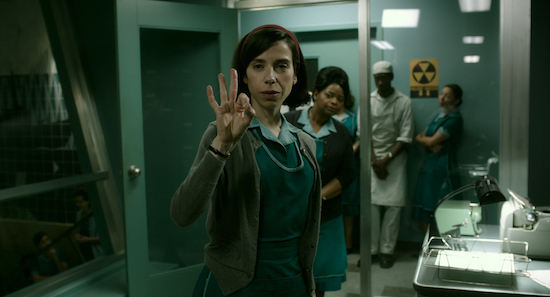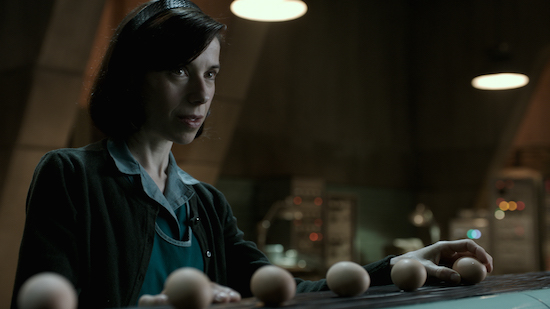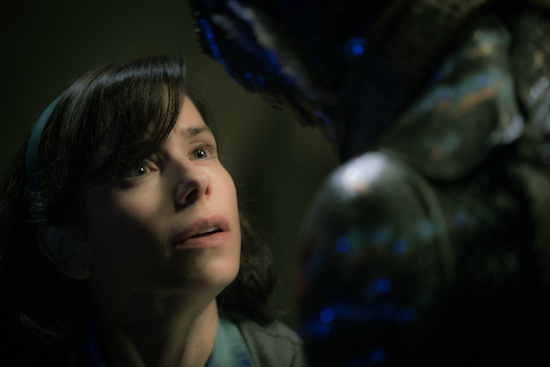“The future is here”. The words are painted on the top of an advertising pitch for a new jelly dessert, a buoyant green pudding that – like so many things in Guillermo Del Toro’s latest fantasy – glows with a preternatural green glow. It is one of the many references to the future, and to the people who will inhabit that future, in a film set determinately in the past. But when we read “the future is here”, where, exactly, do we understand that future to be? Where is this future of which you speak?
Well, let’s start with the present. Where does this film place us? “Would I tell you about the time?” Richard Jenkins’ Giles muses in his opening voiceover. “It happened a long time ago, it seems. In the last days of a fair prince’s reign. Or would I tell you about the place? A small city near the coast, but far from everything else.” The Shape of Water is set in Baltimore in 1962. It is the height of the Cold War and the middle of the Space Race. The “fair prince”, presumably, is JFK. And we are in a distinctly all-American kind of America. This is a world of binary oppositions: of East and West, and human and animal, men and women, the normal and the pathological, the past and the future.
A the same time we are also, somehow, in the timeless France of Jean-Pierre Jeunet’s films (with or without his sometime collaborator Marc Caro) from the 90s and 00s, and the equally atemporal world of Wes Anderson’s cinematic universe. Far more than anything else by Del Toro, the look and the mood and the feel of this film evokes these references and makes us think of these predecessors: nostalgic, slightly twee, magical realist, and heavily stylised in its use of colour.
But from very early on, The Shape of Water also makes us think – quite deliberately – of something else, of precisely what is excluded from these binary oppositions and excluded also from the worlds created by its influences. “Turn that off,” Giles says early on in the film, when Sally Hawkins’ Elisa Esposito changes the channel on the TV to images of African American protest (possibly in Mississippi, over James Meredith’s enrolment at the University of Mississippi). “I don’t want to see that.” The question of who gets to be seen and who is allowed a voice will soon prove to be a recurring and persistent theme throughout The Shape of Water.

The film would appear to arise from the question: What if The Creature from the Black Lagoon was not a sci-fi horror film but a fantasy romance? What if the creature himself – and everyone else denied access to the status of protagonist by the pulp cinema of the 50s and 60s – were allowed to speak, to be given agency? When Hawkins’ mute cleaner Esposito meets Doug Jones’s Amphibian Man their immediate connection, for all its surrealism, is based on the material, organic solidarity of the voiceless (both literal and metaphorical). When she frees him from the shadowy government research station where she works she does so aided by a coalition of precisely those subjects excluded – not only from the Hollywood Silver Age, but equally from the cupcake fantasies of Jeunet and Anderson: gay men, black women, foreign immigrants.
With its central character a mute, this is often a film about finding one’s voice. Elisa’s work colleague Zelda Fuller (played by Octavia Spencer) learns to speak up to her bullish husband. Giles learns to confess his true desires – and when they are rebuffed and he is ejected from the pie shop where the object of his desire works at the same time as a young African American couple, he discovers his solidarity with those others excluded by the dominant narrative of his time.

The Shape of Water, finally, is a love letter to cinema. Giles and Elisa live above a cinema, they spend their days watching Fred and Ginger films and imitating their dance moves, the make-up and overall look of the ‘Amphibian Man’, quite clearly (and Del Toro has admitted as much), is based heavily on Millicent Patrick’s design for the Gill Man from The Creature from the Black Lagoon (who was, herself, for many years denied credit for her work by the film’s make-up artist Bud Westmore). But it is a cautious, critical love letter; a love letter that at the same time upbraids its addressee and pulls it up for its failings, draws its attention to everything and everyone it chose to forget about. The Shape of Water may well be a film steeped in the past, but its concerns are for the future, Hollywood’s future. Will the letter arrive at its destination? What will hatch from this egg of a film?
The Shape of Water is at cinemas now


